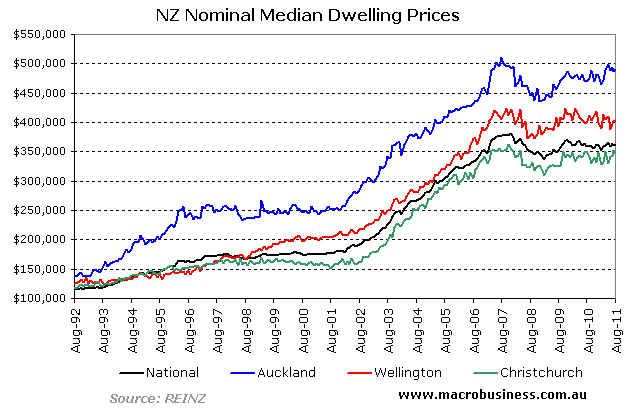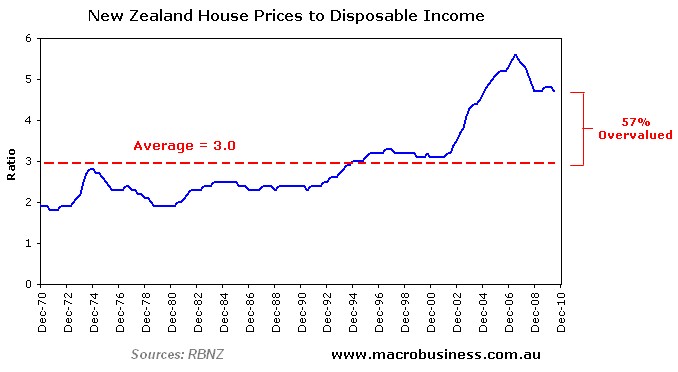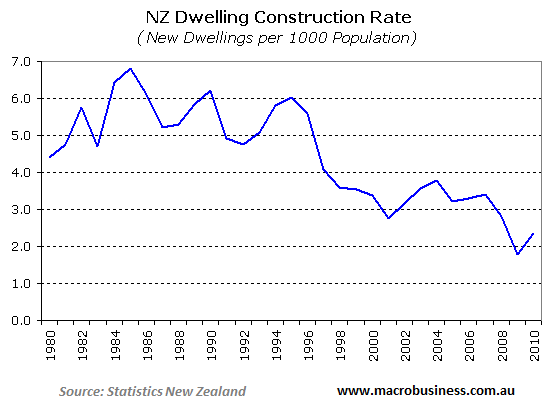
Here’s one of the dumbest proposals that I have read in a while. The Auckland Council has released a Draft Plan proposing to change the existing urban growth boundary (called the “Metropolitan Urban Limit” or MUL) into an even tighter “Rural Urban Boundary” that would effectively ban development outside of the rural-urban line and limit the area in which development can take place. The Draft Plan also sets a target that 75% of all development over the next 30 years will take place within the existing built-up area (i.e. “brownfield development”), meaning that Auckland would need to build up rather than out.
It is hard to understand why the Auckland Council would even consider implementing tighter planning controls than those that exist currently. Auckland’s existing MUL has already driven urban land prices to obscene levels – according to research by respected economist Arthur Grimes, now the chairman of the Reserve Bank, this limit has made land immediately inside the MUL between eight and 13 times more expensive than land immediately outside. In the process, the MUL has helped make Auckland’s housing amongst the most expensive in the English-speaking world (see below chart) and made Auckland more densely populated than Vancouver, Melbourne, Portland, Adelaide, Perth or Brisbane.

Perhaps the most galling aspect of the Draft Plan is that it directly contradicts the Auckland Council’s own submission to the New Zealand Productivity Commissions Inquiry into Housing Affordability, which highlight’s concerns about the potential pernicious impacts of the existing MUL:
Council recently commissioned Ian Mitchell, an independent consultant, to prepare a report which synthesised existing research and analysis of the critical elements in housing affordability with a particular focus on land supply. This work was peer reviewed by Arthur Grimes (MOTU reports attached). Mitchell concluded that:
- There did appear to be a significant boundary effect which was likely to influence land values within the MUL. Consequently, this was likely to have impacted on house prices and housing affordability across the region. Thus, the MUL was likely to have limited land supply during the mid 2000s resulting in higher house prices.
- There may also be benefits associated with this that at least partly offset some of the costs associated with higher land prices; however, these have never been quantified. Lack of significant opportunity to intensify existing urban area outside the CBD may have also meant that some of the accrued from the MUL could have been lost.
In peer reviewing Mitchell’s report, Grimes also noted that scale and competition were also important considerations in releasing land:
- One issue of constrained land supply that needs to be considered by planners is the need for scale when developing land. Interviews with developers indicate that it is cheaper (per lot) to develop at a large scale than on a small scale. Thus simple figures of XX years of available land supply can be quite misleading if much of this supply is based on small developable areas rather than a range of potential large-scale developments. In addition, planners must be careful not to assume that just because sections can be subdivided that they will be. These are private choices and for a whole host of reasons, it will be sub-optimal for many people to choose to subdivide their section. Estimates of available land will therefore be over-stated where assumptions are made that subdividable land will be subdivided.
- A related point is that it is important to ensure that developers are competing with each other for the right to develop, so as to ensure that the land is offered at the most affordable price. Where competition amongst developers is limited by land availability constraints, the resulting prices will incorporate monopolistic rents (leading to high land and house prices).
The last point on competition raised in the Auckland Council’s submission is an important one. The Productivity Commission’s own issues paper noted claims of undesirable ‘land banking’ in Auckland, whereby owners of land within the MUL have deliberately restricted land release in anticipation of future price increases.
However, the presence of land banking is unique to situations where land supply is constrained. This is because land banking is only profitable where the value of land is rising faster than the cost of capital. And in the absence of physical barriers to land supply, land price increases above the level of inflation are driven by policies and regulations that artificially restrict the supply of land.
There is little point land banking in open land markets, like those that exist in ‘middle America’, because land prices typically rise no faster than the general rate of inflation and interest payments are likely to exceed the potential capital gain. Moreover, the existence of high levels of competition in open land markets makes land banking particularly risky, as another nearby owner always has the opportunity to move to the market ahead of you.
Put simply, land banking is a symptom of regulatory (or other) restrictions on land supply.
To be fair to Auckland, urban growth boundaries and other restrictive land-use policies have been prevalent in all of New Zealand’s major housing markets since the 1990s. And these policies have led to a combination of highly unaffordable housing:

As well as falling rates of new dwelling construction:

And the costs of such policies have extended well beyond housing affordability to the macroeconomy. As noted recently by the Reserve Bank of New Zealand (RBNZ):
Supply constraints matter a lot for determining housing market outcomes… This is particularly so for countries or regions with fast growing populations, like New Zealand. In the long‐run, evidence suggests that significant supply constraints lead both to bigger house price booms and eventually to nastier house price corrections…
Large swings in house prices over the cycle matter primarily to the extent that they change consumption behaviour, by easing collateral constraints or leading households to think that their real wealth has increased. The associated wealth effects can bring forward consumption…, residential investment decisions and drive up inflation (as firms increase their output price in response to stronger demand)…
House prices swings can often be costly. They can distort the allocation of resources, detract from economic efficiency and, at times, threaten financial stability…
Policy should focus on the first‐best solution – providing a regulatory environment that gets the underlying supply conditions right. New Zealand needs to ensure that land use can change relatively readily towards the most valuable use for that land, especially if its population is to continue to grow relatively rapidly. New Zealand also needs a regulatory environment that enables a highly productive residential construction sector. In combination, such changes to the supply conditions would help limit the risk of large future swings in house prices when demand shifts occur. House price swings of the sort that we have seen recently are damaging to New Zealand’s overall economic performance. At times, house price cycles can also unnecessarily complicate macroeconomic policy and pose avoidable risks for individual and system‐wide financial stability.
In a similar vein, former RBNZ Governor, Don Brash, also recently questioned the efficacy of New Zealand’s planning system and the adverse impacts on the macroeconomy:
We borrow money offshore to bid against each other for overpriced houses, paying interest on those loans, then attempt to compete against those who have lent us the money. As another former Reserve Bank economist, Rodney Dickens, has put it: “How can a small, export oriented country facing huge disadvantages because it is half a world away from some of its major markets be competitive when housing costs 30-43% more than in the U.S.?”…
There’s absolutely no shortage of land, but the myriad of constraints placed on its use has strangled the supply of land available for people to build their lives and homes…
I hope for New Zealand’s sake that sanity prevails and the Auckland Council’s Draft Plan is thrown out and replaced with a more responsive market-oriented planning system. Otherwise, the cycle of unaffordable housing and boom/bust cycles will become entrenched.
Better still, planners, politicians and industry practitioners early next year will have the opportunity to fly directly from Auckland to Houston, Texas to learn how to build houses properly and efficiently. Let’s hope they exercise this option.

